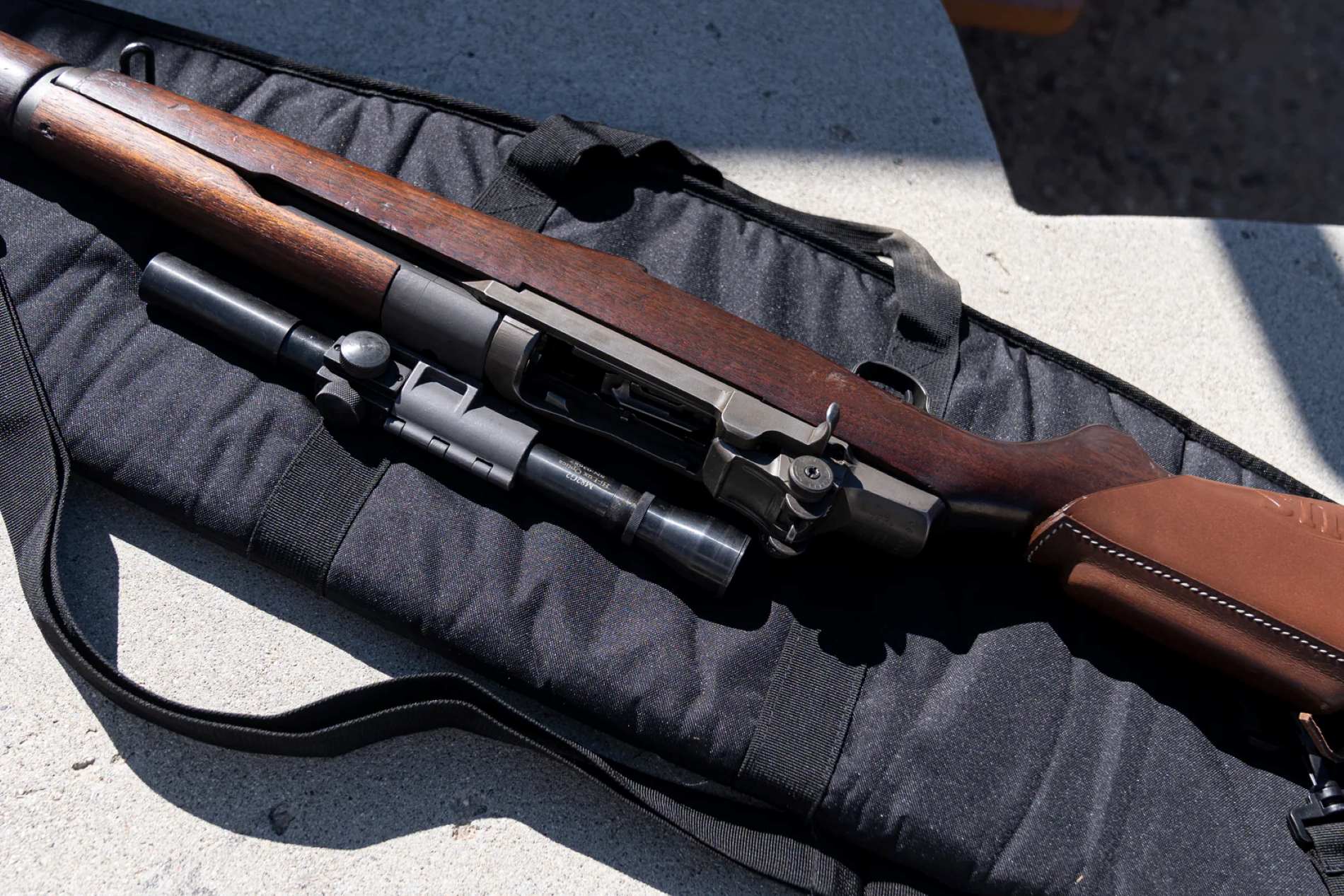
The M1 Garand is a legendary firearm that holds a significant place in military history. Developed in the late 1930s and widely utilized during World War II and the Korean War, this semi-automatic rifle revolutionized infantry warfare. Known for its robustness, reliability, and supreme firepower, the M1 Garand became the standard-issue weapon of the United States Armed Forces for over three decades. Its formidable impact on the battlefield and its timeless design continue to captivate gun enthusiasts and historians alike.In this article, we will explore 15 fascinating facts about the M1 Garand, shedding light on its development, impact, and unique characteristics. From its innovative loading mechanism to its role in shaping the tactics of American troops, we will delve into the lesser-known aspects of this iconic firearm. So, settle in and get ready to uncover some intriguing information about the M1 Garand!
Key Takeaways:
- The M1 Garand was a game-changer in military history, with its semi-automatic action and powerful .30-06 cartridge, revolutionizing warfare and earning praise from General George S. Patton.
- Its iconic “ping” sound, influence on later firearms, and continued use by ceremonial honor guards highlight the lasting impact and legendary status of the M1 Garand in military history.
The M1 Garand was the first standard-issue semi-automatic rifle for the U.S. military.
The M1 Garand, officially adopted in 1936, revolutionized warfare with its semi-automatic action, allowing for faster and more efficient firing.
It was named after its designer, John C. Garand.
The rifle was developed by John C. Garand, a Canadian-born American firearms designer, and it was named in his honor.
The M1 Garand was chambered in .30-06 Springfield.
The rifle fired the .30-06 Springfield cartridge, which was a powerful and widely used round during World War II and beyond.
It had an 8-round internal magazine.
The M1 Garand featured an internal magazine that could hold up to 8 rounds of .30-06 ammunition, which gave it a significant advantage over bolt-action rifles of the time.
The M1 Garand played a crucial role in World War II.
During World War II, the M1 Garand became the standard rifle for the U.S. Army and Marines, greatly contributing to the success of American forces on the battlefield.
General George S. Patton called it “the greatest battle implement ever devised.”
General George S. Patton praised the M1 Garand, recognizing its effectiveness and reliability in combat situations.
It had a distinctive “ping” sound when the clip was ejected.
The M1 Garand made a distinct sound, often referred to as a “ping,” when the empty clip was ejected, which became a recognizable feature of the rifle.
The M1 Garand’s design influenced later firearms.
The successful design principles of the M1 Garand influenced other firearms, including the development of the M14 rifle, which saw service during the Vietnam War.
It had a maximum effective range of over 500 yards.
The M1 Garand had a maximum effective range of approximately 500 yards, making it a formidable weapon in combat situations.
The M1 Garand used an en-bloc clip to feed ammunition.
The rifle utilized an en-bloc clip, which held all 8 rounds together and was inserted directly into the internal magazine.
It had a gas-operated system.
The M1 Garand used a gas-operated system, where the gas from the fired round was tapped to cycle the action and chamber a new round.
The M1 Garand remained in service until the late 1950s.
While the M1 Garand saw extensive use during World War II and the Korean War, it was gradually replaced by the M14 rifle in the late 1950s.
It is considered one of the best battle rifles in history.
The M1 Garand is widely regarded as one of the best battle rifles ever created, gaining a reputation for its reliability, accuracy, and overall performance.
The M1 Garand is a highly sought-after collector’s item.
Due to its historical significance and iconic status, the M1 Garand is highly prized by firearm enthusiasts and collectors worldwide.
The M1 Garand is still used by ceremonial honor guards today.
In recognition of its legacy, the M1 Garand is still used by ceremonial honor guards, paying homage to the rifle’s role in military history.
Conclusion
The M1 Garand is an iconic American rifle that played a significant role in shaping military history. With its innovative design, reliable operation, and formidable firepower, it became the weapon of choice for US troops during World War II and the Korean War. Its impact on the battlefield and its enduring legacy within the firearms community are undeniable.
From its development by John C. Garand to its adoption by the US military, the M1 Garand has left an indelible mark on the firearms industry. Its semi-automatic action and high-capacity magazine set it apart from other rifles of its time, while its accuracy and durability earned the respect and trust of soldiers on the front lines.
Today, the M1 Garand continues to captivate enthusiasts and collectors, with its historical significance and timeless design. Whether on display or in the hands of a skilled shooter, this rifle remains a symbol of American ingenuity, valor, and the sacrifices made by those who served.
FAQs
1. What is the M1 Garand?
The M1 Garand is a semi-automatic rifle that was used by the US military during World War II and the Korean War. It was the first standard-issue semi-automatic rifle and had a capacity of eight rounds.
2. Who designed the M1 Garand?
The M1 Garand was designed by John C. Garand, a Canadian-born American engineer. His design was selected by the US Army in 1936 and went on to become one of the most iconic rifles in history.
3. What caliber does the M1 Garand fire?
The M1 Garand fires the .30-06 Springfield cartridge, which is a powerful and effective round known for its long-range accuracy and stopping power.
4. How many M1 Garands were produced?
An estimated 6.25 million M1 Garands were produced during its production run from 1936 to 1957. These rifles were manufactured by various government arsenals and private companies.
5. Can I still buy an M1 Garand today?
Yes, the M1 Garand is still available for purchase from various sources. The Civilian Marksmanship Program (CMP) is a popular option for buying authentic M1 Garands that were once used by the military.
6. Is the M1 Garand legal to own?
Yes, the M1 Garand is legal to own in the United States, subject to federal, state, and local laws. It is classified as a Curio and Relic (C&R) firearm by the Bureau of Alcohol, Tobacco, Firearms, and Explosives (ATF).
7. How accurate is the M1 Garand?
The M1 Garand is known for its exceptional accuracy. It was designed to be a battle rifle capable of engaging targets at medium to long ranges. With proper maintenance and ammunition, it can achieve consistent and precise shots.
8. How does the M1 Garand function?
The M1 Garand operates using a gas-operated piston system. When a round is fired, some of the gases are redirected to drive a piston, which cycles the action and chambers a new round.
9. Is the M1 Garand still used by the military?
The M1 Garand is no longer in active military service but has been replaced by more modern firearms. However, it is still used ceremonially by honor guards and is highly regarded as a symbol of military tradition.
10. Can the M1 Garand be modified or customized?
Yes, the M1 Garand can be modified or customized to a certain extent. However, it is important to ensure that any modifications comply with legal requirements and do not compromise the rifle’s reliability or safety.
Was this page helpful?
Our commitment to delivering trustworthy and engaging content is at the heart of what we do. Each fact on our site is contributed by real users like you, bringing a wealth of diverse insights and information. To ensure the highest standards of accuracy and reliability, our dedicated editors meticulously review each submission. This process guarantees that the facts we share are not only fascinating but also credible. Trust in our commitment to quality and authenticity as you explore and learn with us.


